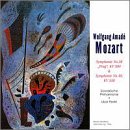| All Artists: Mozart, Pesek, Sspo Title: Sym 38-40 Mozart Members Wishing: 0 Total Copies: 0 Label: T-Rax Basic Classics Release Date: 5/2/2000 Genre: Classical Styles: Historical Periods, Classical (c.1770-1830), Symphonies Number of Discs: 1 SwapaCD Credits: 1 UPCs: 9007684100256, 938454106446, 900768410025 |
Search - Mozart, Pesek, Sspo :: Sym 38-40 Mozart
 | Mozart, Pesek, Sspo Sym 38-40 Mozart Genre: Classical
|
Larger Image |
CD Details |
CD ReviewsElegant performances of Mozart Samhot | Star Land | 06/04/2003 (5 out of 5 stars) "Wolfgang Amadeus Mozart was simply a musical wonder in my book, and from listening to some of his works, it's not surprising that he gets many accolades. On here, Libor Pesek conducts the Slovak Philharmonic Orchestra on Mozart's 38th and 40th symphonies - two of his most popular works.Symphony No. 38 ("Prague") was first performed in the city of Prague back in 1787, which is where the symphony got it's sub-heading. The piece seems to contrast both warm sentiment and pensive, melancholy thought, but without grandiosity of demeanor (mostly exemplified in his 41st/"Jupiter" symphony), nor the deep despair mostly exemplified in his 40th symphony. The first movement entitled Adagio - Allegro seems to fit more into the former category, as the passages seem quite energetic and bouncy, especially in the minor scales played on here. Once again, the overall mood is quite balanced, not excessive in happiness or sadness. The second movement is more subdued and reflective, while the last movement called Presto (which does mean fast, or fairly fast) seems to return to the fast tempo of the first movement, and seems to be a recapitulation of the first two movements. Symphony No. 40 seemed like a left turn for Mozart. There's the diurnal demeanor of the 38th ("Prague"), the exuberant, floating, and elusive evening beauty of the 39th ("Swan Song"), and the grandiose, larger than life 41st ("Jupiter") symphony. But, amongst all of these, the 40th does not feature much of the lightness of mood, or theatrical exuberance the aforementioned three symphonies exuded. Your first tip off: the key is in G minor. Popular consensus says that most major key symphonies exude a happy mood, or a balanced one at minimum, while minor key symphonies exude a darker, more brooding demeanor. I'd have to agree with that for the most part. Much of this symphony is darker in shade compared to most of Mozart's other symphonies, not to mention one of the very few in his output that's in a minor key. The symphony reminds me of someone, particularly an outgoing, adventurous person, looking out of his home window, while being snowed in from a heavy snowstorm, which in return, dampens the otherwise high-spirited adventurer, whose normally outgoing, extroverted demeanor has turned reclusive and depressive. This is pretty much what the symphony represents to me: sort of a fall from grace, or someone dealing with psychological, mental, physical or material loss.Some of the passages on here are some of the most beautiful, heart-tearing, piercing, brooding, frightening and morbid pieces I've heard, and this aspect seems a bit more accentuated because Mozart is not usually known for pained works. The first movement called Molto allegro, while sad and reclusive-sounding, is played at a fairly fast tempo. Elsewhere, conductor Josef Krips does an interpretation of this, and it's a bit slower, and I reckon that the slower tempo brings out the melancholy, brooding mood a bit more, but, this is just a minor quibble that can easily be overlooked, since the melancholy mood is still felt here. The second movement called Andante, surprisingly features some passages that actually recall bits of his 39th, which may be a symbol that there was a bit of hope amongst all the gloom after all. Other than that, many of the passages seem elegant, and many of the phrases play out in ascending & descending mode, but in a strained demeanor, as if Mozart himself was trying desperately to recapture the lighthearted spirit he usually retains in his symphonies. The third movement called Menuetto: Allegretto plays out like a short segue to the fourth and final movement called Allegro assai. Like with most symphonies, this final movement seems like a recapitulation. In this case, a recap of beauty in all of it's forms: pain, frustration and hope - loss & resurrection of it. Some of those things may not exactly be beautiful, but this music certainly is.Not much more can be said from me. If you're not familiar with Mozart or classical music in general, Mozart's music is one of the best things to start your classical journey with. Or even if you don't plan a journey into classical, it's still good to own just a piece of greatness. Highly recommended."
|

 Track Listings (7) - Disc #1
Track Listings (7) - Disc #1